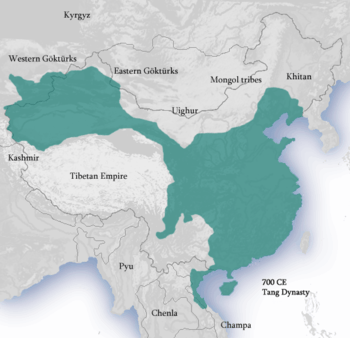Zhou dynasty (690–705)
| Wu Zhou Dynasty (Second Zhou Dynasty) 周 | |||||||||
|---|---|---|---|---|---|---|---|---|---|
| 690–705 | |||||||||
 Zhou Dynasty c. 700 | |||||||||
| Capital | Shendu (Luoyang) | ||||||||
| Common languages | Chinese | ||||||||
| Religion | Buddhism (state religion), Taoism, Confucianism, Chinese folk religion | ||||||||
| Government | Absolute Monarchy | ||||||||
| Empress | |||||||||
• 690–705 | Wu Zetian | ||||||||
| History | |||||||||
• Established by Wu Zetian | 16 October 690 | ||||||||
• Disestablished | 22 February 705 | ||||||||
| 705 | |||||||||
| Currency | Chinese coin, Chinese cash | ||||||||
| |||||||||
| Today part of |
| ||||||||
The Wu Zhou (/dʒoʊ/;[1] Chinese: 周), also called the Second Zhou dynasty or Restored Zhou dynasty, was a Chinese dynasty established by Wu Zetian in 690, when she proclaimed herself huangdi (emperor). The dynasty interrupted the Tang dynasty until its abolition in 705, when Wu Zetian abdicated and Tang rule was restored.
Its sole ruler was Wu Zhao, who took the name Wu Zetian upon her coronation. Wu named her dynasty after the ancient Zhou dynasty, from whom she believed herself to be descended.
History
The dynasty's capital was Shendu[2] (神都 "Divine Capital", present-day Luoyang). Despite Wu's infamous rise to power, there is evidence that suggests women were granted more privileges during her reign, and China was in a state of great prosperity during her rule.
The dynasty's state religion was Buddhism. It is not clear when Wu Zetian became a supporter of Buddhism, but she likely chose Buddhism as the state religion to legitimize her mandate for rule, as Confucianism did not allow female emperors.[2] Furthermore, she claimed to be an incarnation of Maitreya, writing a document called the Great Cloud Sutra, which prophesied that a female emperor would eradicate illness, worry and disaster from the world. She sought the support of the Buddhist clergy to this end. Unlike her predecessor's dynasty, Wu Zetian selected people in her government based on their skills, and not on their status. The Buddhist clergy created a document called Commentary on the Meaning of the Prophecy about Shenhuang, which predicted a female Chakravartin who would rule the Jambudvipa as the reincarnation of Vimalaprabha. This document was presented to Wu Zetian two months before the proclamation of the Zhou Dynasty.
Various other documents were also written such as The Great Spell of Unsullied Pure Light, also predicting the rise of a female monarch, of which Wu Zetian ordered 100,000 copies be printed and distributed.[3]
Traditionalist Chinese historiography considers the dynasty as a period of the Tang dynasty, as Wu was also the former empress consort of a Tang emperor and was buried in Qianling Mausoleum, a Tang royal mausoleum. Furthermore, Wu Zetian was the only emperor of Zhou China, which does not fit the concept of a dynasty. There were, however, other dynasties of a similar length, such as the Xin dynasty, or much shorter in length, such as the Shun dynasty. Wu Zetian's rule was long also seen as a period of great tyranny, though in more recent decades this seems to have lessened or reversed, as the appearance of Wu Zetian in countless Chinese works of fiction seems to depict her as a wise ruler.
Background
Before her coronation, Wu Zhao (as she was then known), was often acting as de facto regent for her husband, Emperor Gaozong, or her sons. Beginning in 655, Wu began to preside over court meetings in the name of the emperor. After Gaozong's death, she ruled in name of her sons, who ruled officially as puppet emperors. In 690, she deposed her son, Emperor Ruizong, and declared herself Huangdi (emperor) of her Zhou Dynasty.